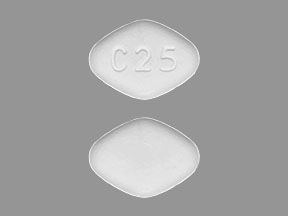Rucaparib Dosage
Medically reviewed by Drugs.com. Last updated on Jan 3, 2025.
Applies to the following strengths: 200 mg; 250 mg; 300 mg
Usual Adult Dose for:
Additional dosage information:
Usual Adult Dose for Ovarian Cancer
600 mg orally twice a day
Duration of therapy: Until disease progression or unacceptable toxicity
Uses: For the maintenance treatment of patients with a deleterious BRCA (breast cancer gene) mutation (germline and/or somatic)-associated recurrent epithelial ovarian, fallopian tube, or primary peritoneal cancer who are in a complete or partial response to platinum-based chemotherapy
Usual Adult Dose for Fallopian Tube Cancer
600 mg orally twice a day
Duration of therapy: Until disease progression or unacceptable toxicity
Uses: For the maintenance treatment of patients with a deleterious BRCA (breast cancer gene) mutation (germline and/or somatic)-associated recurrent epithelial ovarian, fallopian tube, or primary peritoneal cancer who are in a complete or partial response to platinum-based chemotherapy
Usual Adult Dose for Peritoneal Cancer
600 mg orally twice a day
Duration of therapy: Until disease progression or unacceptable toxicity
Uses: For the maintenance treatment of patients with a deleterious BRCA (breast cancer gene) mutation (germline and/or somatic)-associated recurrent epithelial ovarian, fallopian tube, or primary peritoneal cancer who are in a complete or partial response to platinum-based chemotherapy
Usual Adult Dose for Prostate Cancer
600 mg orally twice a day
Duration of therapy: Until disease progression or unacceptable toxicity
Comments:
- This indication was approved under accelerated approval based on objective response rate and duration of response; continued approval may depend on verification and description of clinical benefit in confirmatory trials.
- Selection of patients for treatment should be based on a US FDA-approved companion diagnostic for this drug.
- Patients should also receive a gonadotropin-releasing hormone (GnRH) analog concurrently or should have had bilateral orchiectomy.
Use: For the treatment of patients with a deleterious BRCA mutation (germline and/or somatic)-associated metastatic castration-resistant prostate cancer (mCRPC) who have been treated with androgen receptor-directed therapy and a taxane-based chemotherapy
Renal Dose Adjustments
Mild to moderate renal dysfunction (CrCl between 30 and 89 mL/min): No adjustment recommended
Severe renal dysfunction (CrCl less than 30 mL/min): Data not available
Comments:
- CrCl as estimated by the Cockcroft-Gault method
Liver Dose Adjustments
Mild to moderate liver dysfunction (total bilirubin up to 3 times the upper limit of normal [3 x ULN] or AST greater than ULN): No adjustment recommended
Severe liver dysfunction (total bilirubin greater than 3 x ULN and any AST): Data not available
Dose Adjustments
Interruption of therapy or dose reduction should be considered to manage adverse reactions.
Recommended Dose Reductions:
- Starting dose: 600 mg orally twice a day
- First dose reduction: 500 mg orally twice a day
- Second dose reduction: 400 mg orally twice a day
- Third dose reduction: 300 mg orally twice a day
Hematological Toxicities:
- This drug should not be started until patients have recovered from hematological toxicity caused by previous chemotherapy (grade 1 or less).
- For prolonged hematological toxicities (greater than 4 weeks): This drug should be interrupted or the dose should be reduced as recommended above; blood counts should be monitored weekly until recovery.
- If levels have not recovered to grade 1 or less after 4 weeks of if myelodysplastic syndrome (MDS)/acute myeloid leukemia (AML) is suspected: Patients should be referred to a hematologist for further investigations (including bone marrow analysis and blood sample for cytogenetics).
- If MDS/AML is confirmed: This drug should be discontinued.
Precautions
CONTRAINDICATIONS: None
Safety and efficacy have not been established in patients younger than 18 years.
Consult WARNINGS section for additional precautions.
Dialysis
Data not available
Other Comments
Administration advice:
- Select patients for maintenance treatment of recurrent ovarian cancer based on the presence of a deleterious BRCA mutation (germline and/or somatic).
- A US FDA-approved test for the detection of deleterious germline and/or somatic BRCA mutations is not currently available.
- Select patients for the treatment of mCRPC based on the presence of a deleterious BRCA mutation (germline and/or somatic) in plasma specimens.
- A negative result from a plasma specimen does not mean that the patient's tumor is negative for BRCA mutations.
- If the plasma specimen has a negative result, consider performing further genomic testing using tumor specimens as clinically indicated.
- Administer with or without food.
- Administer doses about 12 hours apart.
Storage requirements:
- Store at 20C to 25C (68F to 77F); excursions permitted to 15C to 30C (59F to 86F).
General:
- For information on US FDA-approved tests for detection of a BRCA mutation in patients with ovarian cancer or with prostate cancer: www.fda.gov/CompanionDiagnostics
Monitoring:
- Hematologic: CBC for cytopenia (at baseline) and for clinically significant changes (monthly thereafter during therapy)
Patient advice:
- Read the US FDA-approved patient labeling (Patient Information).
- Contact health care provider if you experience weakness, feeling tired, fever, weight loss, frequent infections, bruising, bleeding easily, breathlessness, blood in urine/stool, laboratory findings of low blood cell counts, or a need for blood transfusions.
- Patients of childbearing potential: Inform health care provider if you are pregnant or become pregnant; use effective contraception during therapy and for 6 months after the last dose.
- Male patients with female partners of childbearing potential or who are pregnant: Use effective contraception during therapy and for 3 months after the last dose.
- Male patients: Do not donate sperm during therapy and for 3 months after the last dose.
- Use appropriate sun protection because the susceptibility to sunburn is increased during therapy.
- Do not breastfeed during therapy and for 2 weeks after the last dose.
- If a dose is missed or vomiting occurs after taking a dose, do not take an extra dose; take the next dose at the regular time.
Frequently asked questions
More about rucaparib
- Check interactions
- Compare alternatives
- Reviews (1)
- Side effects
- During pregnancy
- Drug class: PARP inhibitors
- Breastfeeding
- En español
Patient resources
Other brands
Professional resources
Other brands
Related treatment guides
Further information
Always consult your healthcare provider to ensure the information displayed on this page applies to your personal circumstances.


